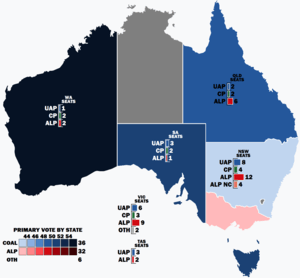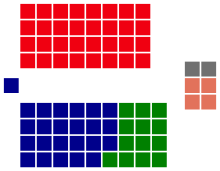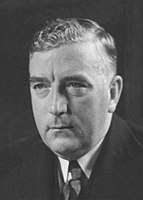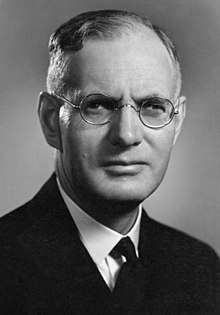1940 Australian federal election
The 1940 Australian federal election was held in Australia on 21 September 1940. All 74 seats in the House of Representatives and 19 of the 36 seats in the Senate were up for election. The incumbent Coalition, consisting of the United Australia Party led by Prime Minister Robert Menzies and the Country Party led by Archie Cameron, defeated the opposition Labor Party under John Curtin despite losing the overall popular vote.
| |||||||||||||||||||||||||||||||
All 74 seats of the House of Representatives 38 seats were needed for a majority in the House 19 (of the 36) seats of the Senate | |||||||||||||||||||||||||||||||
|---|---|---|---|---|---|---|---|---|---|---|---|---|---|---|---|---|---|---|---|---|---|---|---|---|---|---|---|---|---|---|---|
| |||||||||||||||||||||||||||||||
 Popular vote by state with graphs indicating the number of seats won. As this is an IRV election, seat totals are not determined by popular vote by state but instead via results in each electorate. | |||||||||||||||||||||||||||||||
| |||||||||||||||||||||||||||||||
The Coalition had won 36 seats, two short of a majority, but formed a government on 28 October 1940 with the support of both independent crossbenchers, Alexander Wilson and Arthur Coles. The four MPs elected to Lang Labor's successor, the Australian Labor Party (Non-Communist), officially re-joined the ALP just months after the election in February 1941, bringing the ALP seat tally up to 36. The UAP–Country minority government lasted only until October 1941, when the two independents crossed the floor and allowed the ALP to form a minority government with Curtin as prime minister. It remains the only time since the 1910 introduction of an elected two-party system where the government changed as the result of a parliamentary confidence vote.
Future opposition leaders H.V. Evatt and Arthur Calwell both entered parliament at this election.
Background
Until the 1940 Canberra air disaster on 13 August, Menzies was not planning an election so early, as it was not due until December 1940 or even as late as January 1941. However, the loss of three Cabinet ministers meant that three by-elections would have been required, followed within a few short months by a general election. Bringing the general election on earlier than planned was the preferred solution.
Both the Coalition and Labor supported Australia's ongoing participation in World War II. The Coalition's advertisements asked Australians to "Cast Your Vote for Unity and an All-in War Effort / Back the Government that's Backing Churchill", with a large picture of the British Prime Minister. Labor promised "A New Deal / for the Soldier / for the Soldier's wife / Widows, the Aged and Infirm / the Taxpayer / the Working Man / the Primary Producer".[1]
Results
House of Representatives

| Party | Votes | % | Swing | Seats | Change | ||
|---|---|---|---|---|---|---|---|
| UAP–Country coalition | 1,703,185 | 43.93 | –4.65 | 36 | –8 | ||
| United Australia | 1,171,788 | 30.22 | –3.49 | 23 | –5 | ||
| Country | 531,397 | 13.71 | –1.84 | 13 | –3 | ||
| Labor | 1,556,941 | 40.16 | −3.01 | 32 | +3 | ||
| Lang Labor | 202,721 | 5.23 | +5.23 | 4 | +4 | ||
| State Labor | 101,191 | 2.61 | +2.61 | 0 | 0 | ||
| Defence Movement | 15,313 | 0.40 | +0.40 | 0 | 0 | ||
| Protestant Labor | 8,300 | 0.21 | +0.21 | 0 | 0 | ||
| Independents | 289,335 | 7.46 | +1.90 | 2 | 0 | ||
| Total | 3,876,986 | 74 | |||||
| Two-party-preferred (estimated) | |||||||
| UAP–Country coalition | 49.70 | −0.90 | 36 | −8 | |||
| Labor | 50.30 | +0.90 | 32 | +3 | |||
- Notes
- Independents: Arthur Coles (Henty, Vic) (see below), Alexander Wilson (Wimmera, Vic)
- The Country Party in Victoria was split over membership of the Coalition, with the state party opposing its members taking office. The official United Country Party elected two members, one of whom, George Rankin, sat in the federal Country Party room and the other, Alexander Wilson, sat as an Independent. A breakaway faction, the Liberal Country Party, was formed to support sitting ministers and elected two members, John McEwen and Thomas Paterson, who both sat in the federal Country Party room.
Senate
| Party | Votes | % | Swing | Seats Won | Seats Held | Change | ||
|---|---|---|---|---|---|---|---|---|
| UAP–Country coalition | 1,831,138 | 50.41 | +3.70 | 16 | 19 | –1 | ||
| UAP–Country joint ticket | 1,649,241 | 45.40 | +16.72 | 10 | N/A | N/A | ||
| United Australia | 181,897 | 5.01 | –11.12 | 6 | 15 | –1 | ||
| Country | N/A | N/A | N/A | 0 | 4 | 0 | ||
| Labor | 1,363,072 | 37.52 | –10.96 | 3 | 17 | +1 | ||
| Non-Communist Labor | 274,861 | 7.57 | +7.57 | 0 | 0 | 0 | ||
| State Labor | 70,091 | 1.93 | +1.93 | 0 | 0 | 0 | ||
| Defence Movement | 9,536 | 0.26 | +0.26 | 0 | 0 | 0 | ||
| Independents | 84,119 | 2.32 | –1.07 | 0 | 0 | 0 | ||
| Total | 3,632,817 | 19 | 36 | |||||
- Notes
- Of the ten senators elected on UAP–Country joint tickets, seven were UAP members and three were Country Party members.
Seats changing hands
| Seat | Pre-1940 | Swing | Post-1940 | ||||||
|---|---|---|---|---|---|---|---|---|---|
| Party | Member | Margin | Margin | Member | Party | ||||
| Barton, NSW | United Australia | Albert Lane | 1.8 | 13.9 | 12.1 | H. V. Evatt | Labor | ||
| Calare, NSW | Country | Harold Thorby | 2.2 | 5.6 | 3.4 | John Breen | Labor | ||
| Cook, NSW | Labor | Tom Sheehan | N/A | 33.9 | 13.6 | Tom Sheehan | Labor (N-C) | ||
| Dalley, NSW | Labor | Sol Rosevear | N/A | 14.9 | 7.2 | Sol Rosevear | Labor (N-C) | ||
| Denison, Tas | Labor | Gerald Mahoney | 3.9 | 5.0 | 1.1 | Arthur Beck | United Australia | ||
| Henty, Vic | United Australia | Henry Gullett | N/A | 3.2 | 13.5 | Arthur Coles | Independent | ||
| Lang, NSW | Labor | Dan Mulcahy | N/A | 13.4 | 16.0 | Dan Mulcahy | Labor (N-C) | ||
| Macquarie, NSW | United Australia | John Lawson | 2.1 | 10.2 | 8.1 | Ben Chifley | Labor | ||
| Maranoa, Qld | Country | James Hunter | 4.3 | 5.9 | 1.6 | Frank Baker | Labor | ||
| Riverina, NSW | Country | Horace Nock | 7.2 | 8.8 | 1.6 | Joe Langtry | Labor | ||
| Wakefield, SA | Labor | Sydney McHugh | 6.7 | 10.0 | 3.4 | Jack Duncan-Hughes | United Australia | ||
| Wannon, Vic | United Australia | Thomas Scholfield | 1.3 | 5.0 | 3.7 | Don McLeod | Labor | ||
| Warringah, NSW | Independent | Percy Spender | 1.9 | 23.6 | 25.5 | Percy Spender | United Australia | ||
| Watson, NSW | United Australia | John Jennings | 3.8 | 5.8 | 2.0 | Max Falstein | Labor | ||
| West Sydney, NSW | Labor | Jack Beasley | 100.0 | 64.3 | 14.3 | Jack Beasley | Labor (N-C) | ||
| Wilmot, Tas | Labor | Lancelot Spurr | 0.2 | 5.2 | 5.0 | Allan Guy | United Australia | ||
- Members in italics did not contest their seat at this election.
See also
- Candidates of the Australian federal election, 1940
- Members of the Australian House of Representatives, 1940–1943
- Members of the Australian Senate, 1941–1944
Notes
- Hasluck, Paul (1965). Australia in the War of 1939–1945. Series 4 – Civil - Volume 1, The Government and the People, 1939–1941. Canberra: Australian War Memorial. pp. 256–263.
References
- University of WA election results in Australia since 1890
- Two-party-preferred vote since 1937

